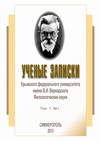The article deals with the types of linguistic gender markers and the general principles of their use in the process of constructing femininity models in the discourse of Turkish everyday and literary speech. The article examines the explicit attitude of society to the feminine principle in Turkish and the use of gender-marked vocabulary as a means of conveying various connotations. The lexicographic material of the article includes gender-marked lexical units containing in one form or another an indication of gender, words with evaluative semes serving to characterize women and various phenomena. The vocabulary containing gender markers according to the metaphorical principle was identified: 1) nominations representing biological characteristics of females; 2) a group of artifactomorphisms using physiological similarity or similarity of character/temper of a woman; 3) mythomorphisms; 4) nominations using indications of a woman’s age and her status in the family/marriage. A separate group consists of names in which the semantic features of the female gender are also supported by a morphological indicator and female names. A tendency to form negatively connoted gender-marked neologisms is recorded. This gives an idea of how external features of femininity, entrenched in Turkish culture, are extrapolated by the language to vocabulary not associated with biological gender: phytonyms, zoonyms, artifacts, etc. — based on external or internal similarity. The methods of morphological transmission of the semantic feature of gender in borrowed words are noted. A lexical way of transmitting the feature of female gender using the word kadın («woman») is also indicated.
urkish language, gender marked vocabulary, constructs of gender vocabulary.
1. Demeshkina T. A., Tolstova M. A. Koncepciya dialektnogo slovarya genderno markirovannoy leksiki // Sibirskiy filologicheskiy zhurnal. – 2022. – №2. – S. 187–200.
2. Gricenko E. S. Zhenschiny i zhenstvennost' v amerikanskom predvybornom diskurse // Vestnik Moskovskogo gosudarstvennogo universiteta. Ser. 19, Lingvistika i mezhkul'turnaya kommunikaciya.
3. Gricenko E. S. Yazyk kak sredstvo konstruirovaniya gendera: dis. … d-ra filol. nauk. ‒ N. Novgorod, 2005. – 401 s.
4. Demeshkina T. A., Tolstova M. A. Gendernaya dialektologiya i slovari kak ee istochnik // Voprosy leksikografii. – 2017. – № 12. – S. 83–105.
5. Demeshkina T. A., Tolstova M. A. Koncepciya dialektnogo slovarya genderno markirovannoy leksiki // Vestnik Tomskogo gosudarstvennogo pedagogicheskogo universiteta. – 2021. – 3 (215). – S. 17-24
6. Efremov V. A. Gendernye stereotipy i russkaya leksikografiya // Vestnik Novosibirskogo gosudarstvennogo pedagogicheskogo universiteta. – 2016. – № 6. – S. 100–111
7. Zykova I. V. Gendernyy komponent v strukture i semantike frazeologicheskih edinic sovremennogo angliyskogo yazyka: dis. ... kand. filol. nauk. ‒ M., 2002. ‒ 219 s.
8. Kirilina A. V. Vozmozhnosti gendernogo podhoda v antropoorientirovannom izuchenii yazyka i kommunikacii // Kavkazovedenie. ‒ 2002.‒ № 2. ‒ S.134‒141.
9. Kirilina A. V. Gender: lingvisticheskie aspekty. ‒ M.: Izd-vo in-ta sociologii RAN, 1999. – 189 s.
10. Kolesnikova M. S. Leksikograficheskie aspekty sovremennyh gendernyh issledovaniy // Gender kak intriga poznaniya: Gendernye issledovaniya v lingvistike, literaturovedenii i teorii
11. Rezanova Z. I. Gendernaya metafora: tipologiya, leksikograficheskaya interpretaciya, kontekstnaya reprezentaciya // Vestnik Tomskogo gos. un-ta. Filologiya. – 2011. – № 2 (14). – S. 47–57.
12. Ryabova T. B., Mutaev U. K., Karusheva Yu. M. «Rodina-mat'» v simvolicheskoy politike sovremennoy Rossii glazami rossiyan // Zhenschina v rossiyskom obschestve. Etnopolitologiya: gendernye
13. Dalkıranoğlu B. Kadınla İlgili 20 Kelimenin Anlamı ve Etimolojik Kckeni. // Liste List. – 2017. – 8 Mayıs. – Available from: https://listelist.com/kadinla-ilgili-kelimeler/ (accessed 25 January 2025).





